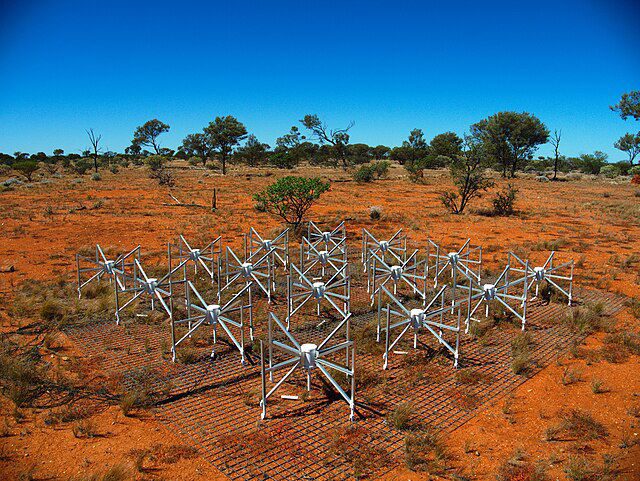
A team of American astronomers from Brown University recently encountered an intriguing puzzle when the Australian Murchison Widefield Array radio telescope picked up an unexpected and bewildering signal.
The Murchison telescope comprises over four thousand spider-like antennas, specifically created to capture radio waves that are over 13 billion years old. These signals journey from the farthest reaches of the universe before arriving on Earth.
The intrigue intensified when an unanticipated signal disrupted this finely tuned device, originating from a nearby television broadcast.
Uncovering a Radio Telescope Enigma
Situated within a government-designated quiet zone, Murchison is protected from radio communication devices—including radio transmitters, television signals, Bluetooth technology, and mobile devices—to maintain the integrity of its observations. Nevertheless, a rogue signal managed to interfere with the telescope’s readings.
“It then dawned on us,” explained Jonathan Pober, a physicist at Brown University and the U.S. research director for the Murchison Widefield Array project. “We speculated that the signal might be reflecting off an airplane. These signals have been observed for nearly five years, and several colleagues proposed that they could be related to airplane reflections of television broadcasts.”
“We realized we might actually confirm this theory for the first time.”
Astronomical Sleuths on the Case
Taking on the role of astronomical detectives, Pober and Brown Ph.D. student Jade Ducharme embarked on an investigation to validate their theory. They analyzed data from when Murchison was activated in 2013, as its initial 0.5-second recording intervals offered much clearer data compared to the two-second intervals implemented later to save storage space.
Not only did they uncover evidence supporting the airplane theory, but they also developed a new method for identifying unwanted radio frequencies. As the number of satellites in Earth’s orbit increases, separating noise from meaningful signals is becoming more essential.
“Astronomy is encountering significant challenges,” Pober stated. “There is growing apprehension—backed by reports—that astronomers may soon struggle to conduct high-quality radio observations due to interference from satellite constellations.”
“This poses a unique challenge for telescopes like the Murchison Widefield Array,” Pober noted, “as they monitor the entire sky simultaneously, making it impossible to rotate the telescopes away from satellites.”
Challenges in Radio Astronomy
Radio-frequency interference (RFI) occurs when unwanted signals contaminate radio telescope data, often rendering it unusable. Without a clear model to trace the erratic signals’ origins, scientists have found it nearly impossible to isolate and eliminate them from datasets—until now. Pober and Ducharme’s innovative technique combines near-field tracking corrections to refine the telescope’s focus on nearby objects and beamforming to accurately identify the source of interference.
“It results in an overwhelming amount of data being discarded to ensure that no part of the observation is compromised,” Ducharme remarked.
The duo successfully tracked an aircraft through their two-stage approach, observing how radio waves interacted with it. From their findings, they determined that in one of the several instances studied, a plane was cruising at 492 miles per hour at a height of 38,400 feet, and they identified the television signal as being associated with Australian Digital TV Channel 7.
Despite incomplete flight records preventing them from pinpointing the exact flight number, their innovative application of existing techniques opens new avenues for navigating the increasingly crowded radio telescope landscape.
The Future of Radio Astronomy: A Crowded Sky
“This represents a crucial step toward effectively subtracting human-made interference from astronomical data,” Pober explained. “With precise identification and removal of interference sources, astronomers can retain more of their observations, reduce significant data loss, and enhance the potential for groundbreaking discoveries.”
With the identification method established, the next hurdle will be to eliminate RFI from the affected datasets. Successful implementation of this process will enable astronomers to tackle interference from satellites and other space entities, which are anticipated to be more difficult than solving for planes. The dramatic 40% increase in Earth-orbiting satellites from January 2022 to June 2023 makes this a pressing issue. Even Pober questions whether removing all satellite noise will be achievable; perhaps constructing radio telescopes beyond Earth, such as on the Moon, could be the long-term solution.
“If a quiet sky proves elusive on Earth, perhaps this planet isn’t the optimal location for our observations,” Pober concluded. “Regardless, we must invest in improved data analysis techniques to identify and mitigate human-generated interference.”
Pober and Ducharme’s research paper, titled “Altitude Estimation of Radio Frequency Interference Sources via Interferometric Near-Field Corrections,” was published on February 12, 2025, in Publications of the Astronomical Society of Australia.
Ryan Whalen is a science and technology journalist for The Debrief. He holds an MA in History and a Master of Library and Information Science, along with a certificate in Data Science. Reach him at ryan@thedebrief.org, and follow him on Twitter @mdntwvlf.









